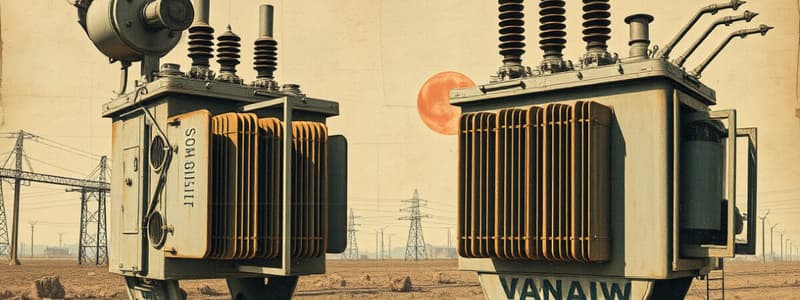Podcast
Questions and Answers
What is a significant advantage of auto-transformers over ordinary transformers?
What is a significant advantage of auto-transformers over ordinary transformers?
- They require more copper than an ordinary transformer.
- They require a smaller magnetising current than a 2-winding transformer of the same rating. (correct)
- They have poorer voltage regulation than a 2-winding transformer.
- They operate at a lower efficiency than a 2-winding transformer.
Which of the following statements is true regarding the construction of auto-transformers?
Which of the following statements is true regarding the construction of auto-transformers?
- They cannot work on both AC and DC.
- They have a larger physical size compared to regular transformers.
- They require less copper than an ordinary transformer of the same rating. (correct)
- They have a more complex design than two-winding transformers.
For what primary purpose are instrument transformers typically used?
For what primary purpose are instrument transformers typically used?
- To generate power in high-voltage circuits.
- To step down the voltage for household appliances.
- To serve as a backup power supply.
- To provide precise measurement and isolation of electrical quantities. (correct)
Where should the primary winding of a potential transformer be connected?
Where should the primary winding of a potential transformer be connected?
What action is crucial for the safe removal of a current transformer?
What action is crucial for the safe removal of a current transformer?
Which of the following statements is correct regarding the efficiency of auto-transformers?
Which of the following statements is correct regarding the efficiency of auto-transformers?
What is a common characteristic of auto-transformers concerning their physical size?
What is a common characteristic of auto-transformers concerning their physical size?
Which of the following describes a disadvantage of using auto-transformers?
Which of the following describes a disadvantage of using auto-transformers?
What is the suitable current transformer ratio to provide a metering current of 0-5A for a 1000kVA load?
What is the suitable current transformer ratio to provide a metering current of 0-5A for a 1000kVA load?
Which potential transformer ratio can provide a metering voltage of 110V from an 11,000V line?
Which potential transformer ratio can provide a metering voltage of 110V from an 11,000V line?
If a current transformer of ratio 100:5 is used, what metering current range can be expected?
If a current transformer of ratio 100:5 is used, what metering current range can be expected?
Which of the following combinations is NOT suitable for metering a 1000kVA load from an 11,000V line?
Which of the following combinations is NOT suitable for metering a 1000kVA load from an 11,000V line?
Why is it important to select the correct ratios for instrument transformers?
Why is it important to select the correct ratios for instrument transformers?
What would be the voltage and current readings on the meters when the line voltage is 10,950V and the line current is 140A?
What would be the voltage and current readings on the meters when the line voltage is 10,950V and the line current is 140A?
What is the primary function of a current transformer?
What is the primary function of a current transformer?
In which environments are instrument transformers commonly utilized?
In which environments are instrument transformers commonly utilized?
Which of the following is NOT a typical use of current transformers?
Which of the following is NOT a typical use of current transformers?
If the line voltage is 10,950V, which value represents a potential reading on an instrument transformer?
If the line voltage is 10,950V, which value represents a potential reading on an instrument transformer?
What type of measurement is primarily supported by instrument transformers in electrical installations?
What type of measurement is primarily supported by instrument transformers in electrical installations?
Which statement about instrument transformers is accurate?
Which statement about instrument transformers is accurate?
When used in high voltage installations, what is the expected outcome of using instrument transformers?
When used in high voltage installations, what is the expected outcome of using instrument transformers?
Which transformer ratio provides a secondary current of 5A from a 200A primary current?
Which transformer ratio provides a secondary current of 5A from a 200A primary current?
What potential transformer ratio would be suitable for a metering voltage of 110V from a higher voltage primary?
What potential transformer ratio would be suitable for a metering voltage of 110V from a higher voltage primary?
If a load requires a measurement of 3000 kVA, which primary-to-secondary CT ratio would be appropriate?
If a load requires a measurement of 3000 kVA, which primary-to-secondary CT ratio would be appropriate?
Which configuration is NOT correct for producing a secondary voltage of 5V from a primary voltage of 300V?
Which configuration is NOT correct for producing a secondary voltage of 5V from a primary voltage of 300V?
Which combination of current transformer and potential transformer would meet the requirement of a 0-5A metering current and 110V metering voltage?
Which combination of current transformer and potential transformer would meet the requirement of a 0-5A metering current and 110V metering voltage?
Which of these is an incorrect statement regarding the effects of primary voltage on secondary amperage in transformers?
Which of these is an incorrect statement regarding the effects of primary voltage on secondary amperage in transformers?
When operating at full load, which of the following ratios converts 300 amps in the primary to 5 amps in the secondary?
When operating at full load, which of the following ratios converts 300 amps in the primary to 5 amps in the secondary?
What happens to the secondary current when the primary current of a transformer is increased?
What happens to the secondary current when the primary current of a transformer is increased?
What is a key disadvantage of an auto-transformer when compared to a double-wound transformer?
What is a key disadvantage of an auto-transformer when compared to a double-wound transformer?
Which of the following is NOT considered an advantage of using auto-transformers?
Which of the following is NOT considered an advantage of using auto-transformers?
Which statement accurately reflects the efficiency of auto-transformers?
Which statement accurately reflects the efficiency of auto-transformers?
What factor primarily contributes to the higher copper loss in auto-transformers?
What factor primarily contributes to the higher copper loss in auto-transformers?
Which application is least appropriate for the use of an auto-transformer?
Which application is least appropriate for the use of an auto-transformer?
In which scenario would adopting an auto-transformer be particularly beneficial?
In which scenario would adopting an auto-transformer be particularly beneficial?
How do auto-transformers compare to traditional transformers in terms of voltage adjustment?
How do auto-transformers compare to traditional transformers in terms of voltage adjustment?
What ongoing maintenance consideration should be taken into account with auto-transformers?
What ongoing maintenance consideration should be taken into account with auto-transformers?
Flashcards are hidden until you start studying
Study Notes
Auto-transformers
- Auto-transformers are more efficient than traditional transformers, requiring less copper for similar ratings.
- They are beneficial for high voltage transformations and possess better voltage regulation.
- Smaller size compared to traditional transformers makes them more space-efficient.
- A significant disadvantage includes high risk when stepping down voltages due to lack of isolation.
Instrument Transformers
- Instrument transformers, including current and potential transformers, are essential for accurate metering and protection in electrical circuits.
- Current transformers (CTs) mainly serve for metering and circuit protection by scaling down high currents.
- Potential transformers (PTs) reduce high voltages to manageable levels for measurement and processing.
Transformer Connections
- The primary of a potential transformer is connected in parallel with the supply for accurate voltage readings.
- To safely remove a current transformer from service, short the secondary winding to prevent damage and ensure safety.
Key Transformer Ratios
- Proper transformer selection involves matching ratios for accurate metering, e.g., CTs and PTs need to be selected for designated metering currents and voltages.
- Example ratios include:
- For a 3000 kVA load: Current transformer with a 200:5 ratio and potential transformer with a 100:1 ratio.
- For a 1000 kVA load: Current transformer with a 75:5 ratio and potential transformer with a 100:1 ratio.
Measurement Interpretation
- It is critical to understand that the current and voltages experienced in the secondary must correspond accurately with those on the primary side, e.g., primary 300 A may produce secondary 5 A in a properly designed CT setup.
- Instrument transformers are commonly employed in test laboratories to ensure precise measurements are maintained.
Studying That Suits You
Use AI to generate personalized quizzes and flashcards to suit your learning preferences.




